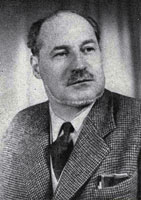
 André-Louis Pierre was born in Chartres, on August 9, 1905. A graduate in Literature, he holds degrees from the Institute of Art and Archaeology, the École du Louvre, and is a former student of the École des Chartes. He studied at the École pratique des Hautes Études (religious sciences, Christian art, iconography and liturgy), and is a decorator, glass painter, and mosaicist, approved by Beaux Arts, attached to the Restoration of Historical Monuments, vice-president of the Société des Artistes Décorateurs. He has participated in its exhibitions since 1942. He had been exhibiting since 1924 at the Salon des Indépendants, during the war at the National des Beaux-Arts, and in 1911 at the Salon d'Automne.
André-Louis Pierre was born in Chartres, on August 9, 1905. A graduate in Literature, he holds degrees from the Institute of Art and Archaeology, the École du Louvre, and is a former student of the École des Chartes. He studied at the École pratique des Hautes Études (religious sciences, Christian art, iconography and liturgy), and is a decorator, glass painter, and mosaicist, approved by Beaux Arts, attached to the Restoration of Historical Monuments, vice-president of the Société des Artistes Décorateurs. He has participated in its exhibitions since 1942. He had been exhibiting since 1924 at the Salon des Indépendants, during the war at the National des Beaux-Arts, and in 1911 at the Salon d'Automne.
- From 1922 to 1928, in Chartres, in the workshop of Lorin, who was in charge of restoring the cathedral's stained glass, he began to learn the trade; from 1928 to 1930, he worked at Barillet;
- From 1931 to 1934, at Gaudin, then became independent and organized, after the Liberation, his own workshop.
- From 1928 to 1930, he executed mosaics and frescoes at the Basilica Notre Dame de Lorette;
- In 1930, in Hénin Liétard, he made his first creations in glass and cement slabs;
- From 1934 to 1939, he created the stained glass windows of the Monastery of the Franciscans, rue Marie-Rose
- In Paris; in 1938, of the Cathedral of Saint Catherine, in Alexandria;
- In 1944, the State entrusted him with those of the Saint Joseph chapels in Montrouge and Saint Jean in Cachan. He has executed numerous sets of mosaics, paintings, frescoes, and stained glass for Historic Monuments. Among others for the church of Saint Pierre and Saint Paul in Montdidier, Saint Nicolas du Port, Damvillers, Beaugency, Blamont, Zetting, and all the windows of the Basilica of the Sacred Heart Fathers in Issoudun.
Professor of history and art techniques at the École Supérieure des Travaux Publics, member of the Superior Council of Fine Arts at the Ministry of National Education, André Pierre has been a Knight of the Legion of Honor since 1952. The art of the glass painter requires the most extensive and complex knowledge.
Clearly, he must familiarize himself with liturgical requirements, and to fuel his inspiration, even in the frequent case where the major stages of the theme are imposed by the clergy, the artist must be able to animate them with all the episodes of the Old and New Testament, not forgetting the poetic treasures of the Golden Legend.
But above all, he must know the technical, material resources of an art whose countless masterpieces constitute a sum of essential principles. Regardless of the freedom of writing, interpretation of the themes treated, this art is dominated by laws to which the glass painter must humbly submit, whether he himself executes, or entrusts a technician with the execution of his cartoon. Because he is a craftsman, André Pierre has studied, through the restoration of ancient stained glass, the manual and spiritual secrets, and he knows how to remain in the authentic tradition.
The overall appearance of a stained glass window is the result of a certain balance between the scale of the pieces of glass that constitute it. This balance is also a function of the data of distance, lighting, orientation, in a word the architectural dispositions in which the stained glass integrates. Figurative or abstract, religious or civil, a stained glass window can fulfill, regardless of its subject, its mission as a translucent wall, and it would seem logical that a significant place is reserved for it, as for tapestry and fresco, in contemporary architecture.
The small stained glass window, inspired by Rimbaud and intended for a library, that André Pierre had presented at the Salon des Décorateurs in 1947, testified in an interesting way, and rich in possibilities of all kinds, to its eventual return to our private homes.
Sources : Mobilier et Decoration N° 1 Fevrier 1955